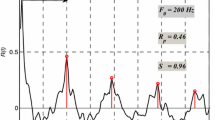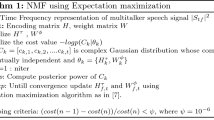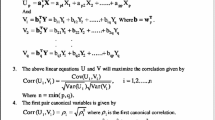Abstract
In this paper we discuss the role of fundamental frequency f 0 and formants F 1, F 2 and F 3 of the speech signal in supervised and unsupervised source separation of real recorded convolutive speech mixtures. Initially supervised source separation is discussed where it is assumed that sources are known a priori. The supervised source separation is discussed by considering (1) only fundamental frequency f 0, (2) only formants F 1, F 2 and F 3, (3) both f 0 and formants F 1, F 2 and F 3. It is observed that last case which involves both f 0 and formants gives most accurate separation results and is used as ideal case or reference to compare the separation results obtained for unsupervised source separation. The unsupervised source separation is discussed, where there is no knowledge about the sources a priori. The unsupervised source separation is discussed using (1) cross correlation of formants of different frames along with f 0 and (2) standard deviation of magnitude of frequency components in F 1, F 2 and F 3 regions of the spectrogram. It is observed that separation results obtained using both unsupervised methods are very close to the ideal case in supervised source separation. The results show that this method works better than some of the classical blind source separation algorithms like independent component analysis and non negative matrix factorization which works well only for the case of instantaneous mixtures where delay is neglected.











Similar content being viewed by others
References
Abrard, F., & Deville, Y. (2005). A time-frequency blind signal separation method applicable to underdetermined mixtures of dependent sources. Signal Processing, 85, 1389–1403.
Amari, S., Douglas, S. C., Chichocki, A., & Yang, H. H. (1997). Multi channel blind deconvolution and equalization using the natural gradient. Proceedings of 1st IEEE workshop signal processing advances wireless Communications, France, pp. 101–102.
Bell, A. J., & Sejnowski, T. J. (1995). An information maximization approach to blind separation and blind deconvolution. Neural Computation, 7, 1129–1159.
Belouchrani, A., & Amin, M. G. (1998). Blind source separation based on time-frequency signal representations. IEEE Transactions on Signal Processing, 46, 2888–2897.
Bofill, P. (2008). Identifying single source data for mixing matrix estimation in instantaneous blind source separation. ICANN, 1, 759–767.
Bofill, P., & Zibulevsky, M. (2001). Underdetermined blind source separation using sparse representation. Signal Processing, 81, 2353–2362.
Douglas, S. C., Sawada, H., & Makino, S. (2005). Natural gradient multi channel blind deconvolution and speech separation using causal FIR filters. IEEE Transactions on Speech and Audio Processing, 13, 92–104.
Fevotte, R., & Gribonval, E. (2005). Vincent, BSS EVAL tool box user guide revision 2. IRISA: Technical Report.
Hershey, J. R., Olsen, P. A., Rennie, S. J., & Aron, A. (2011). Audio Alchemy: Getting computers to understand overlapping speech. Scientific American Online, April 2011. http://www.scientificamerican.com/article/speech-getting-computers-understand-overlapping/.
Jourjine, A., Rickard, S., & Yilmaz, O. (2000). Blind separation of disjoint orthogonal signals: Demixing N sources from 2 mixtures. In Proceedings of the ICASSP, pp 2986–2988.
Karhunen, J., & Oja, E. (2001). Independent component analysis. Hoboken: Wiley.
Loizou P. C. (2003). COLEA: A MATLAB software tool for speech analysis.
Naik, G. R., & Kumar, D. K. (2011). An overview of independent component analysis and its applications. Informatica, 35, 63–81.
Ozerov, A., & Fevotte, C. (2010). Multi channel non negative matrix factorization in convolutive mixtures for audio source separation. IEEE Transactions on Audio, Speech and Language Processing, 18, 550.
Philipos, C. (2011). Loizou. Speech quality assessment, Multimedia Analysis, Processing & Communications, 346, 623–654.
Reju, V., Gkoh, S., & Soon, I. N. (2009). An algorithm for mixing matrix estimation in instantaneous blind source separation. Signal Processing, 89, 1762–1773.
Roy, C., & Milinazzo, F. (1993). Formant location from LPC analysis data. IEEE Transactionson Speech and Audio Processing, 1, 129–134.
Sawada, H., Mukai, R., Araki, S., & Makino, S. (2005). Frequency domain blind source separation, speech enhancement (pp. 299–327). Berlin: Springer.
Smaragdis, P. (1998). Blind separation of convolved mixtures in the frequency domain. Neuro Computing, 22, 21–34.
Smith, D., Lukasiak, J., & Burnett, I. S. (2004). A two channel block adaptive audio separation technique based upon time-frequency information. In Proceedings of the 12th European signal processing conference, pp. 393–396.
Stone, J. V. (2001). Blind source separation using temporal predictability. Neural Computation, 13, 1559–1574.
Stone, J. V. (2004). Independent component analysis: A tutorial introduction. Boston: MIT Press.
Vincent, E., & Bertin, N. (2014). From Blind to guided audio source separation. IEEE Signal Processing Magazine, 31, 107.
Vincent, E., Gribonval, R., & Fevotte, C. (2006). Performance measurement in blind audio source separation. IEEE Transactionson on Speech and Audio Processing, 14, 1462–1469.
Yegnanarayana, B., & Sriramamurty, R. K. (2009). Determining mixing parameters from multi speaker data using speech specific information. IEEE Transactions on Audio, Speech and Language Processing, 17, 1196.
Yilmaz, O., & Rickard, S. (2004). Blind separation of speech mixtures via time-frequency masking. IEEE Transactions on Signal Processing, 52, 1830–1847.
Author information
Authors and Affiliations
Corresponding author
Rights and permissions
About this article
Cite this article
Prasanna Kumar, M.K., Kumaraswamy, R. Supervised and unsupervised separation of convolutive speech mixtures using f 0 and formant frequencies. Int J Speech Technol 18, 649–662 (2015). https://doi.org/10.1007/s10772-015-9309-1
Received:
Accepted:
Published:
Issue Date:
DOI: https://doi.org/10.1007/s10772-015-9309-1




